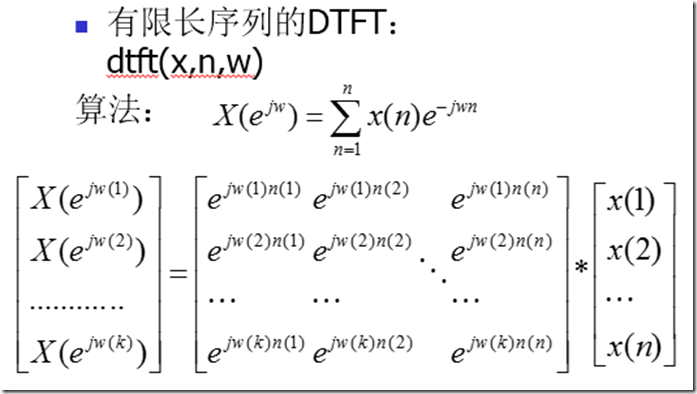数字信号处理实验(一)——DTFT
2016-01-03 09:53
211 查看
1、MATLAB自编绘图函数
function [] = signal_write(X,w,flag)
% X:数据
% w:频率向量
magX=abs(X);angX=angle(X);
realX=real(X);imagX=imag(X);
if(flag == 1)
figure();
magX=abs(X);angX=angle(X);
realX=real(X);imagX=imag(X);
subplot(2,2,1);plot(w/pi,magX);grid
xlabel('以pi为单位的频率');title('幅度部分');ylabel('幅度')
subplot(2,2,3);plot(w/pi,angX);grid
xlabel('以pi为单位的频率');title('相角部分');ylabel('弧度')
subplot(2,2,2);plot(w/pi,realX);grid
xlabel('以pi为单位的频率');title('实部');ylabel('实部')
subplot(2,2,4);plot(w/pi,imagX);grid
xlabel('以pi为单位的频率');title('虚部');ylabel('虚部')
end
if(flag == 2)
plot(w/pi,magX);grid
xlabel('以pi为单位的频率');title('幅度部分');ylabel('幅度')
end
if(flag == 3)
plot(w/pi,angX);grid
xlabel('以pi为单位的频率');title('相角部分');ylabel('弧度')
end
if(flag == 4)
plot(w/pi,realX);grid
xlabel('以pi为单位的频率');title('实部');ylabel('实部')
end
if(flag == 5)
plot(w/pi,imagX);grid
xlabel('以pi为单位的频率');title('虚部');ylabel('虚部')
end2、DTFT变换函数

function[X]=dtft(x,n,w,flag) %计算离散时间付里叶变换 %[X]=dtft(x,n,w) %X=在w频率点上的DTFT数组 %x=n点有限长度序列 %n=样本位置向量 %w=频率点位置向量 X = x * (exp(-j).^(n' * w)); if(flag == 1) signal_write(X,w,1); end
3、采样代码
function [ ] = caiyang(Fs,N,jt,flag)
%UNTITLED3 此处显示有关此函数的摘要
% 此处显示详细说明
% Dt 模拟时间间隔:在特定精度下信号为模拟的
% t 模拟时刻序列
% n 离散时间索引
% Ts 采样周期
% Fs 采样频率
% xa 在特定精度下,由离散信号逼近模拟信号
% jt 是否需要重构
% flag 5 第五题
% 6 第六题
Dt=0.00005; % 模拟时间间隔:在特定精度下信号为模拟的
Ts=1/Fs; % 采样周期
n=-N:1:N; % 离散时间索引
nTs=n*Ts; % 序列时刻索引
t=-N*Ts:Dt:N*Ts; % 模拟时刻序列
if flag == 5
xa=exp(-1000*abs(t)); % 在特定精度下,由离散信号逼近模拟信号
x1=exp(-1000*abs(nTs)); % Fs=5000 样本/s:x1为采样后的离散时间序列
end
if flag == 6
xa=sin(1000*pi*t); % 在特定精度下,由离散信号逼近模拟信号
x1=sin(1000*pi*nTs); % Fs=5000 样本/s:x1为采样后的离散时间序列
end
if flag == 7
xa = sin(20*pi*t + pi/4);
x1 = sin(20*pi*nTs + pi/4);
end
K = 500; % 对pi进行K等分:相当于对单位园2pi进行1000等分
dk = pi/K; % pi 的等分步进索引
w = 0 : dk : pi; % 角度步进索引
X = x1 * exp(-j* n'*w); % 对x1序列做离散傅立叶变换
Xr = real(X);
w = [-fliplr(w),w(2:end)]; % 定义w负半轴
Xr = [fliplr(Xr),Xr(2:end)]; % 由于实部偶对称,得到Xr的负半轴
if jt == 1
figure();
% 绘出xa
subplot(3,1,1)
plot(t*1000,xa);hold on
% 绘出x(jw)
stem(n*Ts*1000,x1,'r.'),hold off,title('时域波形')
% 绘出以pi归一化的数字频率对应的频域实部波形
subplot(3,1,2);plot(w/pi,Xr);title('频域波形')
subplot(3,1,3)
chonggou(x1,Fs,N);
end
if jt == 0
figure();
% 绘出xa
subplot(2,1,1);
plot(t*1000,xa);hold on
% 绘出x(jw)
stem(n*Ts*1000,x1,'r.'),hold off,title('时域波形')
% 绘出以pi归一化的数字频率对应的频域实部波形
subplot(2,1,2);plot(w/pi,Xr);title('频域波形')
end4、重构代码
function [ ] = chonggou(x1,Fs,N)
%UNTITLED4 此处显示有关此函数的摘要
% 此处显示详细说明
% x1 抽样序列
% Fs 采样率
% t 时间轴
% Dt 离散间隔,模拟信号
Dt = 0.00005; % 模拟时间间隔:在特定精度下信号为模拟的
n = -N:N;
nTs = n/Fs;
t = -N/Fs:Dt:N/Fs; % 模拟时刻序列
xa = x1 * sinc(Fs*(ones(length(nTs),1) * t-nTs'*ones(1,length(t)))); % 内插重构
plot(t*1000,xa, 'k' ),hold on
stem(nTs*1000,x1, 'r.' ),hold off ,title('重构波形' )
axis([-N/Fs*1000,N/Fs*1000,min(x1),max(x1)]);
end
相关文章推荐
- 取自己上一层目录路径。
- LeetCode总结 -- 树的性质篇
- UITableViewCell点击样式
- 0928-CALayer
- SDUT 2254 字母螺旋方阵(递归)
- 山河古人
- C++位操作
- mysql进阶(二十)CPU超负荷异常情况
- mysql进阶(二十)CPU超负荷异常情况
- 在Objective-c里面使用property教程
- 静态应用举例2
- 静态应用举例
- Android微信登陆
- centos7下使用yum安装mysql
- 第十五周 用哈希法组织关键字
- MVC,MVP,MVVM之异曲同工
- 静态如何应用?
- Android高德地图开发具体解释
- 151217MainTest主函数详细介绍
- Linux(2) --vim使用(1)
